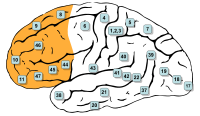
Photo from wikipedia
Frontal alpha asymmetry (FAA) has been explored extensively in affective neuroscience. To determine which FAA indicators are linked with the habitual use of emotion regulation, we recorded the resting electroencephalogram… Click to show full abstract
Frontal alpha asymmetry (FAA) has been explored extensively in affective neuroscience. To determine which FAA indicators are linked with the habitual use of emotion regulation, we recorded the resting electroencephalogram alpha activity. First, we reduced all of the FAA indicators to four factors by exploratory factor analysis. Next, we carried out a multiple regression analysis to determine which factors could significantly predict the habitual use of emotion-regulation strategies. According to the results, greater left-asymmetric activation at the dorsolateral prefrontal cortex predicted increased use of reappraisal, whereas at the ventrolateral prefrontal cortex, it was predicted by right-asymmetric activation. Greater left-asymmetric frontal activity at the posterior dorsolateral prefrontal cortex was related to increased use of distraction and suppression. These results suggest that resting FAA in the prefrontal cortex region plays a significant role in the habitual use of emotion regulation. Video abstract: http://links.lww.com/WNR/A485
Journal Title: NeuroReport
Year Published: 2018
Link to full text (if available)
Share on Social Media: Sign Up to like & get
recommendations!